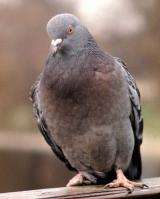October 14, 2010 report
Study shows pigeons like to gamble

(PhysOrg.com) -- A new study of pigeons shows that, like human gamblers, they love to gamble on the off chance they will win big rather than taking a smaller, but more certain payout.
Research by psychologists Thomas Zentall and Jessica Stagner of the University of Kentucky in Lexington found pigeons given a choice of a light that would deliver three pellets of food every time or one that gave them a big “win” of 10 pellets 20 percent of the time consistently chose the latter. When averaged out, these results meant the pigeons were preferring a payout of two pellets for each peck rather than three.
Zentall said similar results had been observed in monkeys, and the reason may be that the larger payout is a surprising change from their expectations, and we learn from these departures from the norm. The same motivation could explain why some humans gamble, ignoring their losses and focusing on the less regular, but more surprising big wins.
In humans many other factors are involved, such as the atmosphere of the gambling location, with colorful and noisy surroundings, and by the possibility of losing what you already have. By using pigeons Zentall and Stagner could study the phenomenon without at least some of these added complications.
The researchers trained eight pigeons to peck at keys that caused a vertical or horizontal light to be displayed on a screen in yellow, blue, red or green colors. In return they received food rewards. If they pecked at the key that presented a horizontal line (yellow or blue) three food pellets were dispensed each time, which therefore represented a non-gambling option. If they pecked on the key for the vertical line, it was one color (say green) 80 percent of the time, in which case no food was delivered. The remaining 20 percent of the time the line was the signal color (say red), in which case 10 pellets were dispensed. The vertical line therefore represented a gambling option. (Color combinations were changed for different birds to avoid any bias.)
After Zentall and Stagner had trained the birds to understand what the lines and colors meant they then carried out many trials to see which the birds preferred. The results were that the pigeons chose the riskier 10 pellets or nothing option in over 80 percent of the trials, even though on average they would receive 50 percent more food if they chose the other option.
In a later experiment they trained seven new pigeons, but this time both red and green colors triggered the release of 10 pellets 20 percent of the time and nothing the rest of the time. The yellow and blue colors still resulted in three pellets being released. In this case the pigeons chose the yellow/blue option for a sure payout of three pellets.
Zentall said the findings suggest the pigeons in the first trials put excess weight on the excitement on the windfall that resulted from a red light, and evening out the odds on red and green detracted from the excitement. He commented that in human gambling watching a winning pattern appear on a slot machine, for example, precedes winning the money, and suggested gamblers would not wager as often if there were no signals for their winning — so slot machine players could not see the wheels, and roulette players could not see the ball.
Zentall said if the pigeons were hungry they tended to gamble more than if they were already satisfied, despite having more to lose, and this has parallels in human gambling studies, which have shown that people who are dissatisfied with their lives and have less money tend to gamble more than those who are wealthier and more satisfied.
The paper was published in the journal Proceedings of the Royal Society B.
More information: Maladaptive choice behaviour by pigeons: an animal analogue and possible mechanism for gambling (sub-optimal human decision-making behaviour), Thomas R. Zentall et al., Proceedings of the Royal Society B, Published online before print October 13, 2010, doi:10.1098/rspb.2010.1607
© 2010 PhysOrg.com















